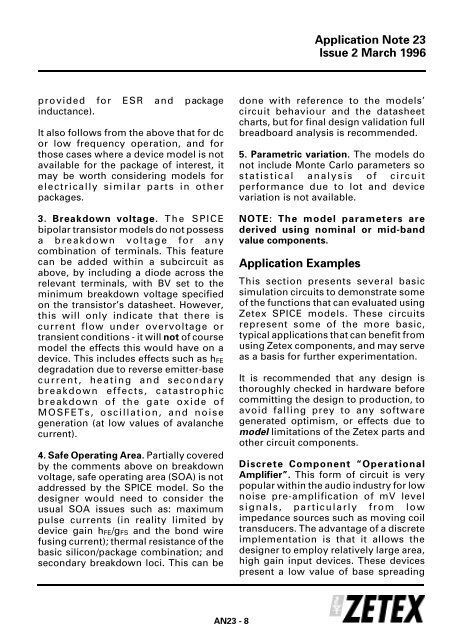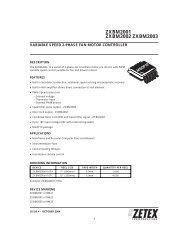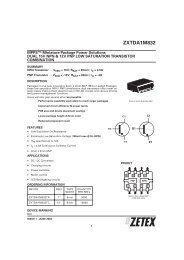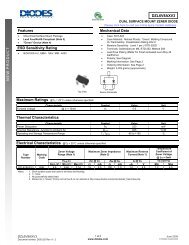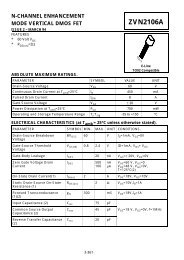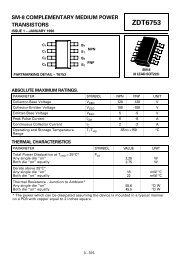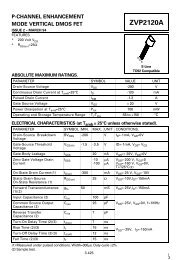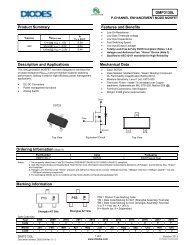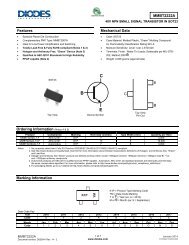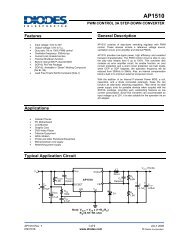Zetex - AN23 - Zetex SPICE models - understanding ... - Diodes, Inc.
Zetex - AN23 - Zetex SPICE models - understanding ... - Diodes, Inc.
Zetex - AN23 - Zetex SPICE models - understanding ... - Diodes, Inc.
Create successful ePaper yourself
Turn your PDF publications into a flip-book with our unique Google optimized e-Paper software.
provided for ESR and package<br />
inductance).<br />
It also follows from the above that for dc<br />
or low frequency operation, and for<br />
those cases where a device model is not<br />
available for the package of interest, it<br />
may be worth considering <strong>models</strong> for<br />
electrically similar parts in other<br />
packages.<br />
3. Breakdown voltage. The <strong>SPICE</strong><br />
bipolar transistor <strong>models</strong> do not possess<br />
a breakdown voltage for any<br />
combination of terminals. This feature<br />
can be added within a subcircuit as<br />
above, by including a diode across the<br />
relevant terminals, with BV set to the<br />
minimum breakdown voltage specified<br />
on the transistor’s datasheet. However,<br />
this will only indicate that there is<br />
current flow under overvoltage or<br />
transient conditions - it will not of course<br />
model the effects this would have on a<br />
device. This includes effects such as hFE<br />
degradation due to reverse emitter-base<br />
current, heating and secondary<br />
breakdown effects, catastrophic<br />
breakdown of the gate oxide of<br />
MOSFETs, oscillation, and noise<br />
generation (at low values of avalanche<br />
current).<br />
4. Safe Operating Area. Partially covered<br />
by the comments above on breakdown<br />
voltage, safe operating area (SOA) is not<br />
addressed by the <strong>SPICE</strong> model. So the<br />
designer would need to consider the<br />
usual SOA issues such as: maximum<br />
pulse currents (in reality limited by<br />
device gain hFE/gFS and the bond wire<br />
fusing current); thermal resistance of the<br />
basic silicon/package combination; and<br />
secondary breakdown loci. This can be<br />
<strong>AN23</strong> - 8<br />
Application Note 23<br />
Issue 2 March 1996<br />
done with reference to the <strong>models</strong>’<br />
circuit behaviour and the datasheet<br />
charts, but for final design validation full<br />
breadboard analysis is recommended.<br />
5. Parametric variation. The <strong>models</strong> do<br />
not include Monte Carlo parameters so<br />
statistical analysis of circuit<br />
performance due to lot and device<br />
variation is not available.<br />
NOTE: The model parameters are<br />
derived using nominal or mid-band<br />
value components.<br />
Application Examples<br />
This section presents several basic<br />
simulation circuits to demonstrate some<br />
of the functions that can evaluated using<br />
<strong>Zetex</strong> <strong>SPICE</strong> <strong>models</strong>. These circuits<br />
represent some of the more basic,<br />
typical applications that can benefit from<br />
using <strong>Zetex</strong> components, and may serve<br />
as a basis for further experimentation.<br />
It is recommended that any design is<br />
thoroughly checked in hardware before<br />
committing the design to production, to<br />
avoid falling prey to any software<br />
generated optimism, or effects due to<br />
model limitations of the <strong>Zetex</strong> parts and<br />
other circuit components.<br />
Discrete Component “Operational<br />
Amplifier”. This form of circuit is very<br />
popular within the audio industry for low<br />
noise pre-amplification of mV level<br />
signals, particularly from low<br />
impedance sources such as moving coil<br />
transducers. The advantage of a discrete<br />
implementation is that it allows the<br />
designer to employ relatively large area,<br />
high gain input devices. These devices<br />
present a low value of base spreading


